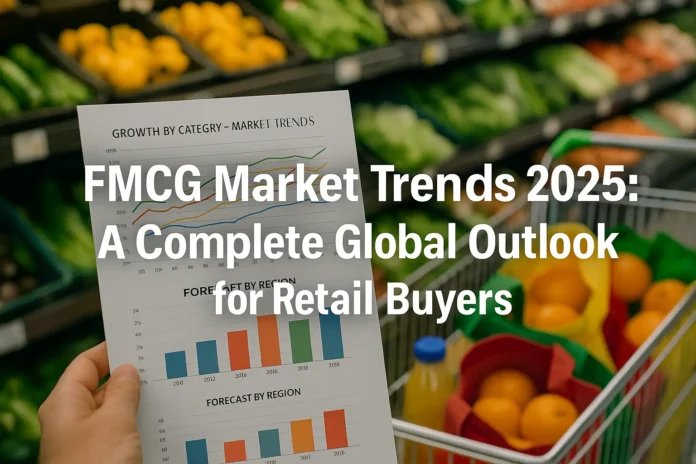Fast-moving consumer goods never stand still. Even when supply chains break, costs jump or shoppers cut back, everyday essentials keep moving from shelf to trolley. But how people buy, what they want and what they trust — all of this is shifting again in 2025.
Retail buyers, brand managers and FMCG suppliers face another year of subtle but serious changes. Growth is solid but the details matter. A slight swing in pack size, shopper loyalty or online share can tip margins fast.
This is not another generic trend list. This is the reality — backed by recent figures, B2B supplier notes, and retailer moves across Europe, the US and fast-growing parts of Asia.
1. The Global FMCG Market Stays Solid — But Watch Margins
According to Euromonitor and other trade watchers, global FMCG turnover will touch $12–13 trillion by end of 2025. That covers food staples, soft drinks, toiletries, cleaning goods — the basics.
Growth is not explosive. Expect 3–5% CAGR on average, with some spikes in niche wellness or plant-based lines. But inflation is sticky. Energy prices and packaging costs still squeeze the middle.
This means buyers have to protect shelf profitability. Price cuts win short-term footfall but dent supplier trust. Smart promotions, loyalty card nudges and pack tweaks matter more than splashy discounts.
2. Private Label: Quietly Grabbing Bigger Baskets
No surprise here. Own brands still gain ground in Europe, and the US is catching up. PLMA data shows store brands now sit at 35–40% share in some EU supermarket baskets. In the US, some banners push above 20% and see double-digit growth when national brands hike prices.
Shoppers are used to it. Premium-tier private labels look slick. Mid-tier is no longer ‘generic’ — it’s just smart shopping.
Buyers reading this know the math: Private label improves margin control. It also pressures suppliers to keep costs tight and quality steady. Expect more tenders for short-run seasonal store brands in 2025.
3. Shopper Loyalty is Fragile
The pandemic taught shoppers to switch. First for safety, then for price. That habit stuck.
Kantar’s consumer panel shows price outweighs brand loyalty on household staples. Loyalty cards partly help but not always. If a rival’s milk or pasta pack drops by 5%, baskets move.
For FMCG buyers, this means routine cost checks on commodity lines — bread, milk, canned staples. Loyalty promotions must reward frequency, not just sign-ups.
4. Health and Sustainability: No Longer Optional
Plant-based lines are not niche anymore. In Europe and North America, younger shoppers expect mainstream supermarkets to carry credible vegan or low-sugar snacks.
At the same time, packaging rules tighten. The EU bans certain single-use plastics outright. Many big chains pledge 100% recyclable or compostable packaging by 2030.
For FMCG brands, this costs money. For buyers, it’s a sorting challenge: Which suppliers are truly compliant? Which brands use green PR but ship heavy plastics inside? Expect more audits.
5. E-commerce is Normal — Not Novel
One number says a lot: Post-COVID, online grocery in mature markets stabilises at 10–15% of total grocery spend. For cities, it’s higher.
Click & collect stays popular. Shoppers want speed and control, not last-mile costs. Small local dark stores pop up near urban hubs to fill that need.
Retail buyers balance online assortment carefully. Not every item sells well in baskets picked by someone else. Fragile items, impulse treats — some stay store-only.
6. Direct Brands and Fast Newcomers
There’s always noise about ‘disruptive direct-to-consumer brands’. Truth is, few scale. But they shape taste.
One health bar goes viral on TikTok, so big retailers list it for real shelf tests. A few thrive, most fade. But buyers watch social buzz more than before.
This means FMCG brand managers must track social listening, not just sell sheets.
7. Regional Pulse — What’s Different
Europe:
Private label leads.
Green rules shape packaging.
Discounters squeeze full-line grocers.
Urban shoppers use apps for same-day top-up shops.
USA:
Club packs stay popular for families.
Loyalty programs push digital coupons.
E-commerce rivals test ultra-fast delivery in big cities.
Value tier still matters more than niche premium.
Asia:
Rapid middle-class growth lifts premium FMCG.
Domestic brands rival big multinationals.
Mobile-first buying is the rule, not exception.
Local sourcing buffers global shipping spikes.
8. Practical Moves for Buyers
Here’s the heart of this piece — not just ‘what’s hot’, but what buyers should do now:
✔ Balance shelf mix: Review national brand vs private label. Add or refine premium store brand lines if margins allow.
✔ Check contracts: Lock costs on basics — sugar, oils, grains — where possible. Review freight deals quarterly, not annually.
✔ Update pack sizes: Test family packs or value multi-buys. Small tweaks shift sales fast.
✔ Pressure-check sustainability: Some suppliers overpromise. Ask for audit proof. Non-compliance fines can kill margins.
✔ Track shopper data: Weekly. Not quarterly. Fast signals matter.
✔ Stay local where possible: Global routes still see sudden delays.
Numbers at a Glance
$12–13 trillion global FMCG turnover (est. 2025)
3–5% CAGR
Private label: 35–40% EU, 20%+ US
Online grocery: ~12% share in mature markets
Expert Take
“Retail buyers who treat 2025 as a ‘normal year’ will lose margin. Treat it as a flexible test lab. Watch data weekly, trust local partners, and fix pricing smartly.”
— FMCG Strategy Advisor, London
What Comes Next
There is no magic trend that flips the whole market. 2025 is about careful balance: value vs premium, store vs online, local vs global.
Buyers and brands that track data daily, stay honest about cost risks, and stay nimble with sourcing will outperform.
Stay Ahead
Global Supermarket News will follow these FMCG market trends for 2025 and beyond. Bookmark us, sign up for alerts, and get the insight before your rivals do.



